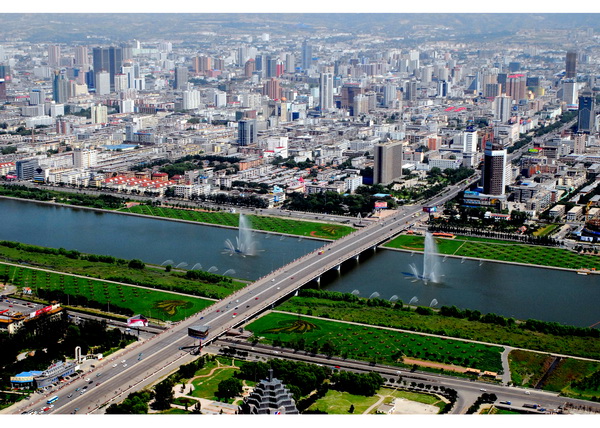News
Taiyuan: Improving ecology, hub for Central China
By Sun Ruisheng (China Daily)
Updated: 2011-06-01 10:31
 |
Large Medium Small |

As the capital of Shanxi province, Taiyuan is the political, financial, technological, cultural and educational center of the province.
It is also a transport hub that joins the west and the east of China.
Its temperate continental monsoon climate means the city has four clearly defined seasons, free from the scathing hot in summer and the biting cold in winter. Mountains flank the city on three sides and the Fenhe River runs through it from north to south.
With a population of 4.2 million, the city covers 6,988 square kilometers, 3.4 percent of which is developed urban area.
The city has six districts - Xiaodian, Yingze, Xinghualing, Wanbolin and Jinyuan - and the counties of Qingxu, Yangqu and Loufan. It also has jurisdiction over the city of Gujiao.
Taiyuan is a city steeped in history. Founded in 497 BC during the Spring and Autumn Period (770-476 BC), it served as the capital or the second capital of nine dynasties. In the late Sui Dynasty (AD 581-618), it was in Taiyuan that Li Yuan and his son Li Shimin began their revolt that went from strength to strength before leading to the establishment of the Tang Dynasty (AD 618-907).
In its long history, Taiyuan has accumulated precious cultural gems including Jinci Temple, lauded as the glittering jewel on the crown of Chinese civilization, Yongzuo Temple, whose soaring towers epitomize the best of Chinese architecture, and Longshan Grottos, the largest Taoist grottos in China.
It is also a city of colorful folk culture including the Jin merchants, a brood of merchants hailing from Shanxi who extended their business across the Eurasian Continent and maintained momentum for five centuries. They constituted an important part of the commercial history of China and even the world.
The legacy left by Jin merchants profoundly contributed to Shanxi culture and exerted a strong influence on modern Chinese history.
Taiyuan was the center of Jin merchant activity. In the Ming Dynasty (1368-1644) and Qing Dynasty (1644-1911), Taiyuan merchants were respected by the Jin traders and many of their associations were based in the city.
The city is also a manufacturing center. Endowed with abundant resources, Taiyuan has developed a strong industrial base, especially in equipment manufacturing. It is the national production center for stainless steel, aluminum and magnesium alloy.
Taiyuan Iron and Steel Co is China's major producer of special steel and the largest maker of stainless steel in the world.
Foxconn (Taiyuan) Industrial Park is the biggest foreign investment program in Shanxi that is focused on research and development of aluminum and magnesium alloy and other new materials, striving to be the world's largest manufacturer of automobile parts made of aluminum and magnesium alloy in the next 10 years.
In the 12th Five Year Plan, Taiyuan, by making the best of its profound culture, its strong industry, the large supply of talent and all kinds of conveniences that its status as a capital bring will stride into a golden period of development, during which opportunities will abound for social and economic endeavors.
Taiyuan is placed in a strategic position in the overall plan of the Shanxi province, serving as a driving force for development of the rest of the province. In the newly released 12th Five Year Plan, Taiyuan is an integral part of the rise of central China, a move that will afford the city numerous opportunities.
On the provincial level, the local government and people's congress support Taiyuan to take the lead in development. The city is positioned at the vanguard of Shanxi's efforts in leapfrogging development to provide impetus for social and economic advancement of the entire province.
Taiyuan has carefully planned its blueprint for the 12th Five Year Plan, during which it will strive be become a top provincial city as well as a metropolitan city with regional clout and worldwide influence.
Specific goals have been outlined: emerging industry will be supported with a top- grade base that will be built; education and attraction of talent will be a priority to help the city evolve into an innovative center; ecology will be protected in efforts to build a city pleasant for living.
In order to build a first-class living-friendly city, effective measures will be taken to improve air quality and restore the ecosystem using the principle "green, low carbon, clean and healthy".
In May, 108 companies that together emit 80 percent of the city's pollution were asked to set emission reduction targets that will then be reviewed by a panel of experts, who are responsible for offering advice and evaluating results.
Worst-performing companies will face closure. Such practice exhibits Taiyuan's unwavering resolve to tackle environmental problems.
Taiyuan aims to become the national model for environmental protection by utilizing clean energy. Industrial pollution will be brought under close supervision, urban slums will be upgraded and heating supplies will be centralized. These measures are dedicated to the eradication of air pollution and the reappearance of blue sky.
Taiyuan also plans to become a forest city, garden city and clean city, an aspiration that will see Taiyuan plant more vegetation, clean the rural and urban landscape and integrate measures on the treatment of lakes and rivers.
Fenhe River Reservoir, the water source for Shanxi province, will be well protected so that water quality will improve and a city of green trees and clear water will reemerge.
Taiyuan will greet September with blossoms of chrysanthemum and the aroma of fruit. From Sept 26 to 28, the sixth Expo Central China will be held when Taiyuan hosts tens of thousands of businessmen. They will find a new Taiyuan - with a better appearance and inclusive spirit - to welcome them with open arms.
(China Daily 06/01/2011 page29)
| 分享按钮 |